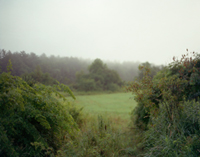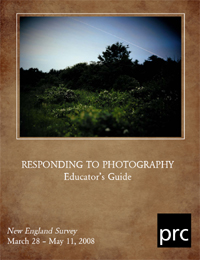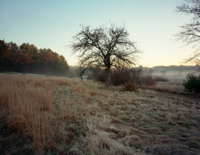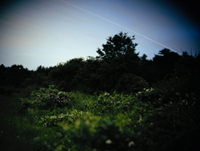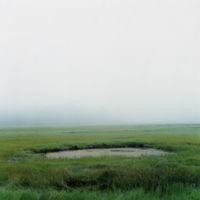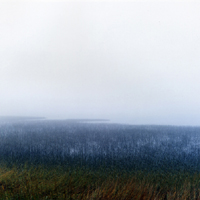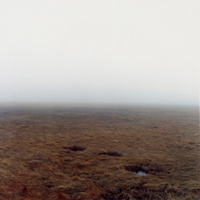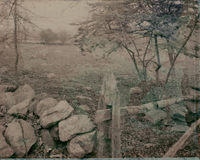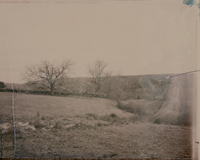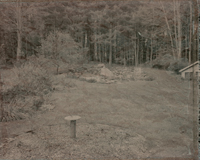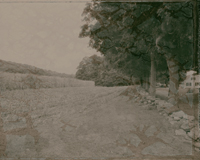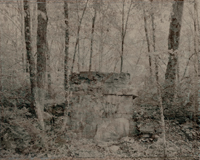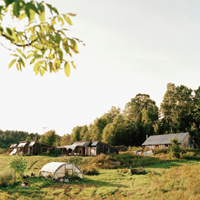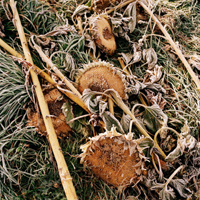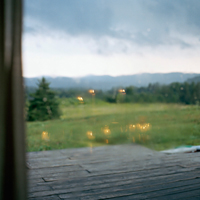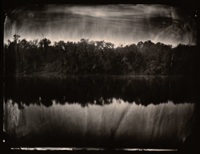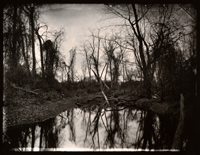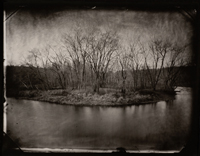| New England Survey |
||
| March 28 – May 11, 2008 This exhibition surveys contemporary work from, of, and about the New England landscape, featuring one artist from (or project based in) each of the 6 New England states: Massachusetts, Rhode Island, Connecticut, New Hampshire, Maine, and Vermont. The photographers/projects include Barbara Bosworth, Jonathan Sharlin, Tanja Alexia Hollander, Janet L. Pritchard, Thad Russell, and
Paul Taylor. New England Survey serves as an occasion and a location in which we can meditate upon on the grander, ineffable “sense of place” unique to this area. Click here to read a review of New England Survey by the Boston Globe's Pulitzer Prize-winning art critic Mark Feeney ABOUT THE ARTISTS “To make a prairie it takes a clover and one bee,One clover and a bee. And revery. The revery alone will do, If bees are few. ” – Emily Dickinson, #1755 Barbara Bosworth (Massachusetts) Whether her 8x10 camera is aimed at the spreading boughs of the largest American Elm or a birder holding a Common Yellowthroat, Barbara Bosworth captures the ineffable and the intimate. Admittedly “obsessed with the physical world,” Bosworth began documenting a meadow on her friend's 20-acre Carlisle property four years ago. Encapsulating both the “here” and “everywhere,” we feel as though we are wandering through her large prints, experiencing the whole cycle of a place—from the moist morning dew to twinkling fireflies at dusk.Bosworth has been a Professor at Massachusetts College of Art + Design since 1984. Her honors include a Buhl Foundation Grant, a New England Foundation for the Arts Fellowship, and a John Simon Guggenheim Memorial Foundation Fellowship. Upcoming solo showings include the Phoenix Art Museum, in conjunction with the Center for Creative Photography, and an exhibition at the Smithsonian American Art Museum. Most recently featured in To Fly: Contemporary Aerial Photography at the Boston University Art Gallery, her photographs are in the collections of numerous museums. Bosworth is regularly featured in Blind Spot and recently published Trees, National Champions (MIT Press, 2005). “The rhythm of walking generates a kind of rhythm in thinking, and the passage through a landscape echoes or stimulates the passage through a series of thoughts.” – Rebecca Solnit Tanja Alexia Hollander (Maine) In an ongoing series and approach to the natural landscape, Tanja Alexia Hollander uses a spur of the moment approach to specific places. Besides the Maine marshes featured in this exhibition, Hollander has similarly interpreted landscapes in New York, Massachusetts, Israel, and Belize. Using high-speed film and focusing on infinity, she snaps the shutter when a moment overcomes her. She tends to return to the same places repeatedly over several years, seeking different seasons and moods. In each meditative image, one almost senses cumulative, composite mental and visual layers of a place experienced over time. Hollander earned her BA from Hampshire College in 1994, studying Photography, Film, and Feminism. Recent solo exhibitions include shows at Bernard Toale Gallery in Boston and Jim Kempner Fine Art in New York City. Featured in the 2007 Portland Museum of Art Biennial, she is represented in collections such as the Bates College Museum of Art and the University of Maine Museum of Art as well as the corporate collections of Polo: Ralph Lauren and Fidelity. Along with fellow Mainer Scott Peterman, she is the founding co-director of the Bakery Photographic Collective. “The past is not dead. In fact, it's not even past.” – William Faulkner Janet L. Pritchard (Connecticut) Janet L. Pritchard's work centers on notions of place and explores the intersection of personal and social issues. This series, “Dwelling: Expressions of Time,” was first conceived while driving her sons to school on a rural Connecticut road and combines analog and digital techniques. Using Polaroid Type 55 positive/negative film, Pritchard processes the film to yield chemical stains. Later while scanning the film, she tinges the scene with color taken from 19th century tintypes. The resulting effects and artifacts echo the remnants of history and culture found in the stone walls and glacial erratics scattered across our New England landscape.Currently an Associate Professor at the University of Connecticut at Storrs, Pritchard holds both an MA and an MFA from the University of New Mexico. Her exhibitions include showings at the Liebling Center for Film, Photography, and Video in Amherst and the Photography Gallery at the University of Rhode Island, Kingston. The curator of the recent Landscape: Fact and Fiction at the William Benton Museum of Art, she has an upcoming fellowship at the American Antiquarian Society in Worcester, MA. Represented by Chicago's Schneider Gallery, her work is included in collections such as the George Eastman House, Polaroid Collections, and the Museum of Fine Arts, Santa Fe. [Home] “is where one starts from…We shall not cease from exploration / and the end of all exploring / Will be to arrive where we started / And know the place for the first time.” – T.S. Eliot Thad Russell (Vermont) Originally from Wayland, MA, Thad Russell lived in California before feeling the pull of his native New England. During graduate school, his mother was diagnosed with and finally succumbed to cancer. For almost two years, Russell divided his time between Providence and his parents' house on 35 acres in Vermont's Northeast Kingdom, just 30 miles south of the Canadian border. Championing a back-to-the-land lifestyle, his parents have lived “off the grid” in their self-built, self-sustaining compound for the last 18 years. Featured in this exhibition are a variety of landscapes from this project, showing the myriad moods of nature—mirroring his and his parent's own—and this magnificent land to which they are so closely tied.A 2006 MFA graduate of the Rhode Island School of Design (RISD), Russell holds a teaching certificate from Brown University and has a background in international relations and art direction. He currently teaches as an adjunct professor at RISD, University of Massachusetts, Amherst, and Providence College. Published in Photo Districts News' Annual, his exhibitions include the Griffin Museum of Photography's 13th Annual Juried Exhibition as well as group shows from Chicago to Los Angeles. “I like to think of landscape not as a fixed place but as a path that is unwinding before my eyes, under my feet.” – Gretel Ehrlich Jonathan Sharlin (Rhode Island) Jonathan Sharlin's sensitivity to place can be seen in his choice of projects—from documenting earth works and landscapes in Scotland, Israel, and India to an ongoing, 18-year documentation of a one-square-mile island in Michigan's Upper Peninsula. Featured in this exhibition is a project closer to home, literally, captured in two of his favorite Rhode Island spots, Weetamoo and Lincoln Woods. A year-round kayaker and hiker, Sharlin spends time outdoors every day walking his dog, often bringing his 4x5 camera. Recently, he has begun to capture two or more images taken from different vantage points, emphasizing the experiential quality of a walk in the woods.Currently a freelance photographer, Sharlin has taught at RISD, Roger Williams University, and the University of Rhode Island, Kingston. Earning an MFA from the Visual Studies Workshop in l978, he has had over twelve solo exhibitions, including shows at Brown University, Fotofest, Blue Sky Gallery, and Duke University. He is the recipient of many grants, including grants from the RI State Council for the Arts, the New England Foundation, and recently, the RI Foundation. He is included in public and private collections, including the Museum of Fine Arts, Houston, Polaroid Collections, and Fidelity Investments. “Place may be the first of all concepts; it may be the oldest of all words” – N. Scott Momaday Paul Taylor (New Hampshire) Most of Paul Taylor's “Connecticut River Landscape” images were taken within a seven-mile radius of his home/studio located in an old barn on the Ashuelot River, a small tributary of the Connecticut River. The longest river in New England, the Connecticut holds a prominent place in its history—from forming the border between early colonies to its depiction in Thomas Cole's famous Oxbow painting. Using the 19th century process of wet plate collodion in the field, Taylor processes the negatives to achieve more pronounced aesthetic results. Printed in gelatin silver, toned with selenium, and stained with tea, the resulting large prints have the feel of vintage photographs and Luminist paintings, yet with a contemporary aura. Taylor earned his MFA in photography from RISD in 1986. Taylor has taught photography and printmaking at RISD, the University of Connecticut at Storrs, and Greenfield Community College. Taylor has exhibited in solo shows from Vermont to Rhode Island to New York City, including a recent retrospective offering at the Hallmark Museum of Photography in Turner's Falls, MA. The director/owner/artist of the photographic atelier Renaissance Press, Taylor is a master photogravure printer, who has worked with artists as diverse as Jim Dine, Kenro Izu, Mark Morrisoe, and Kiki Smith. related education program WORKSHOP: Staring and Wonder Saturday, May 3, 2008, 9am – 4pm Class will meet at the Photographic Resource Center, 832 Commonwealth Avenue $85 PRC & Grub Street Members/$95 Non-Members Registration required. To register please call Grub Street at 617.695.0075 "To make anything interesting," Flaubert says, "you simply have to look at it long enough." And then what? The Photographic Resource Center and Grub Street (A non-profit writing center where Boston Gets Writing) are happy to co-present this one-day writing workshop inspired by the PRC's New England Survey exhibition. We'll begin by discussing some suggestive and provocative statements by a host of writers who care about staring—W.G. Sebald, Flannery O'Connor, John Gardner, Cesare Pavese, Wallace Stevens, George Szirtes, Mark Strand, and Elizabeth Bishop, among others—and then spend the rest of the first part of our day engaged in acts of staring ourselves. The objects of our attention will be the astonishing landscape—based photographs in New England Survey. We'll dedicate the second part of our day to what happens after that something becomes interesting. We'll allow these images of the New England landscape to enlarge of our sense of place and our capacities to pay attention, to wonder, and wander in our writing. We'll follow our eyes—and our imaginations—in words. This workshop is open to all writerly appetites: narrative, poetic, memoiristic, essayistic, imagistic, and beyond. Scott Challener leads this workshop. Challener graduated from Warren Wilson College's MFA Program for Writers in January. In addition to his seminars at Grub Street, he teaches creative writing in Boston University's Metropolitan College and Northeastern University's School of Professional and Continuing Studies, and he has taught for the past two years in BU's Writing Program.  |
Click here to schedule a tour
CALL FOR PHOTOS!
|
|
|
|
||
